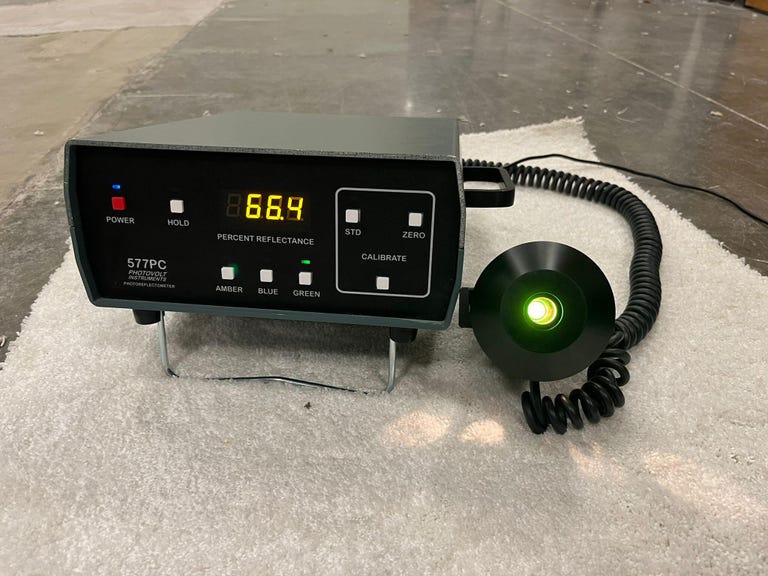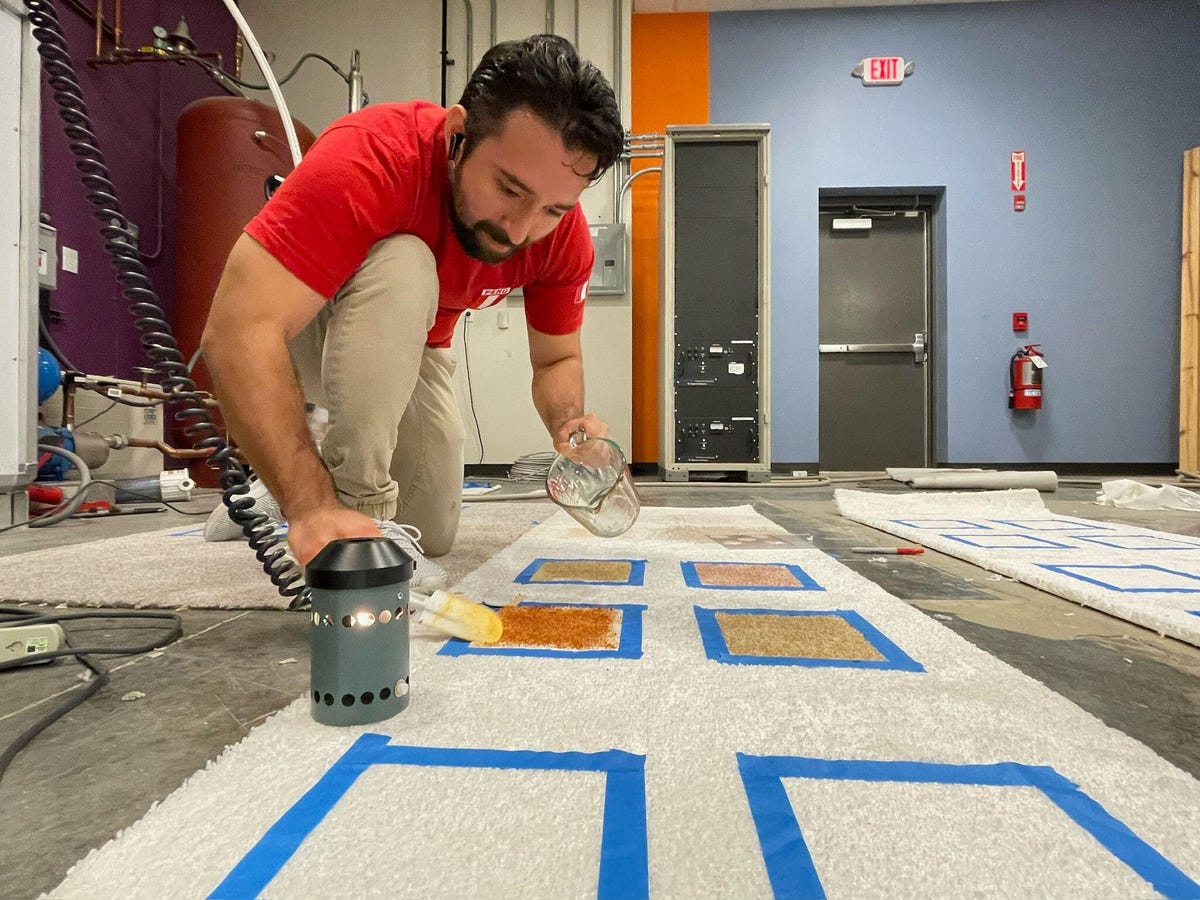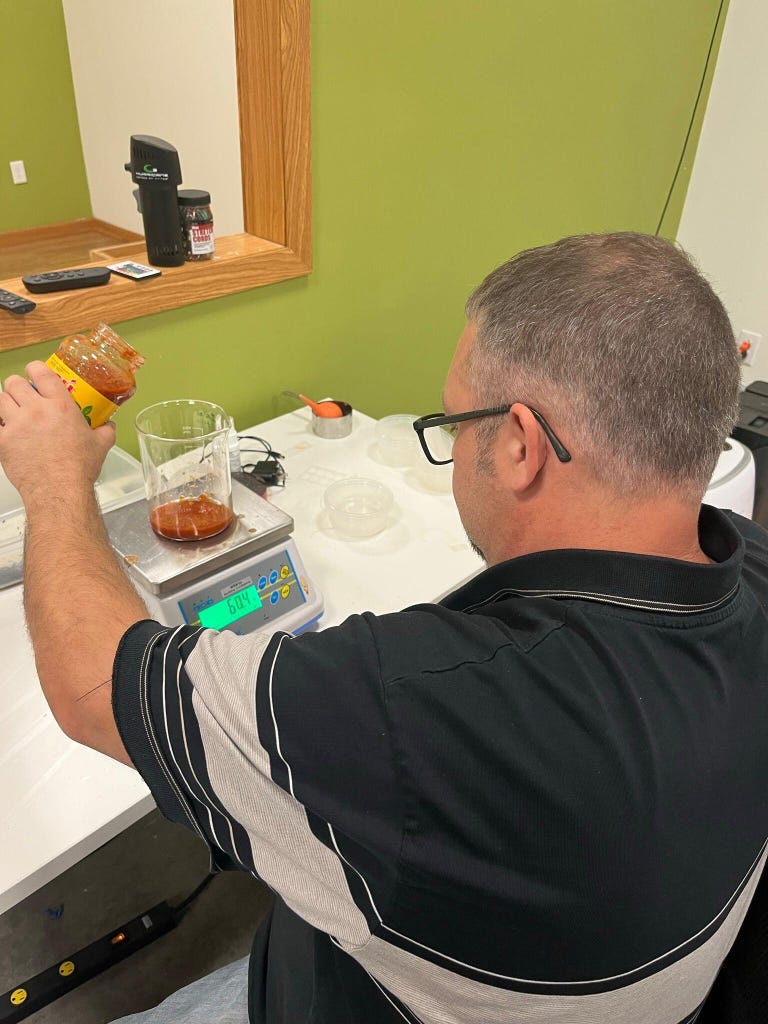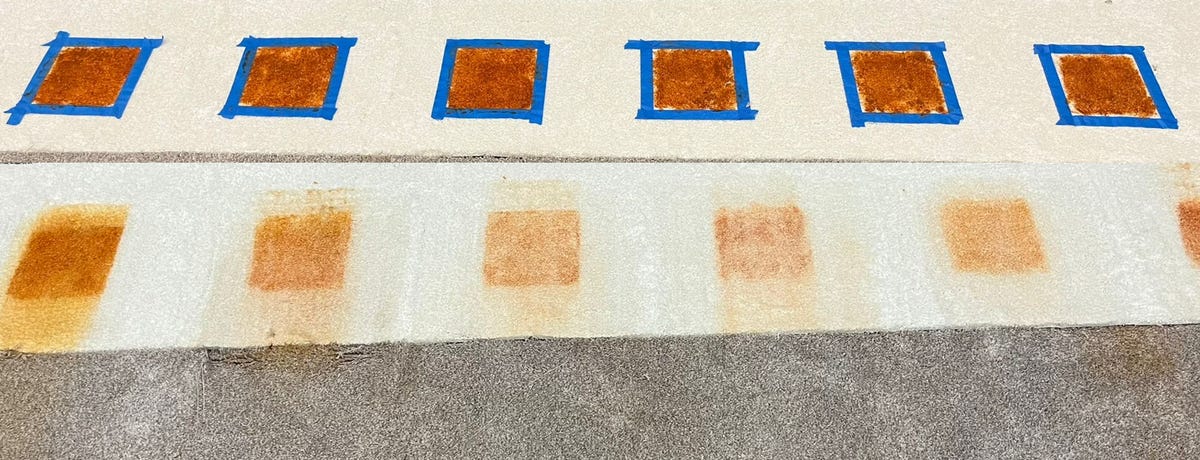For this experiment, I headed to CNET’s product-testing laboratory in Louisville, Kentucky, where I used a reflectometer and a little bit of basic physics to assess the performance of carpet-cleaning machines by comparing their cleaning efficiency when presented with a variety of the most common carpet staining substances.
Color
As you may recall from high school physics, color is just our brain’s interpretation of visible light of different wavelengths. For instance, red corresponds to long, low-energy wavelengths around 700 nanometers, while blue and violet represent short, high-energy wavelengths, with violet having the shortest of these at only 380 nm.
The Electromagnetic Spectrum. Our eyes can only perceive the section in the middle. That’s what we call visible light.
When we observe a red apple, two things are happening simultaneously; the peel of the apple is reflecting only the light of long wavelength (red) and absorbing most of the other light. Our eyes collect this information and immediately relay it to the brain for processing. This is how we can perceive color (red, in this instance) with astounding precision. You may be wondering why black and white are not part of the picture above. That’s because white comprises visible light of all wavelengths combined, while black is the absence of visible light.
That’s all well and good, but how does it all relate to carpet cleaner testing? Glad you asked.
Carpet-cleaning efficiency test
Our eyes can tell the difference between clean and dirty carpet but how do we actually measure that difference? In theory, if we could quantify the light reflected by a carpet sample (that is, to measure its “color”), we could assess the cleaning power of each carpet-cleaning machine by taking color measurements from a brand new piece of carpet and comparing them to measurements obtained after it’s been stained and subsequently cleaned. The ratio of these two reflectivity values (before vs. after) would allow us to assess performance. In my test logic, the more similar those numbers are, the better the carpet was restored to its original color. We could repeat this procedure for every UUT (unit under test) and compare the results… So yeah, that’s exactly what we did.

Photovolt 5700PC Reflectometer and search unit. Inside the search unit, there’s a tristimulus filter that prevents other type of light (i.e. UV and IR) from interfering with the readings, and a photo sensor that measures the amount of light reflected from the surface of the test subject — our white carpet.
Enter the reflectometer, a device of many color-matching applications in industries like textiles and paints. Fortunately, the working principle of the reflectometer applies to our purposes, as well. Our Photovolt Model 577PC Reflectometer has a search unit or “probe” that houses a tungsten bulb that emits light in all directions within a chamber and then measures how much of that light is reflected to its photosensors. This measurement generates a voltage that is linearly correlated to the amount of reflected light perceived by the photosensor, which enables us to quantify light and color. Science!
We will use the whiteness index as our frame of reference. This parameter is used to measure how “white” a sample is by measuring its reflectance under two different light filters (blue and green) and then using an equation to correlate and normalize these values. Since we will be using a white carpet for this test, getting WI values from before and after gives us an accurate representation of how much of the soil and stain was effectively removed from our carpet by each carpet-cleaning machine.
We segmented four 6-by-6-inch “stain squares,” each containing one type of soil. We placed the search unit on top of the brand-new white carpet sample and measured its WI. To ensure repeatability and accuracy, we took five readings at different locations within our soil square and averaged the reflectance readouts.
We selected four substances for staining:
- 150ml sweet red wine: A sugary, alcoholic substance with proven staining power.
- 150ml black coffee: An acidic, everyday substance containing tannin, a naturally occurring dye.
- 150ml motor oil: Our oily stain of choice. Tough to remove since it doesn’t mix well with the water dispensed by the UUT.
- 60g marinara sauce: An organic, tomato-based substance that proved to be the toughest stain to remove.

Staining carpet with sweet red wine, coffee, motor oil and marinara sauce.
We proceeded to soil the squared sections, allowing the contaminants to settle for approximately one hour. Then, we began the cleaning process. Two cleaning cycles were performed on each stained square. A cleaning cycle consists of two wet strokes, followed by four dry strokes. Finally, we measured reflectivity values at the same five locations as previously and averaged them. The ratio of final vs. initial WI values tells us how efficient the carpet-cleaning machine was at restoring the carpet to its original white.
Sample of stained carpet before and after it’s been cleaned by a carpet cleaning machine. Notice that in all instances soil wasn’t removed from carpet efficiently… Can you guess which unit this is? (Hint: It’s not one of the three top picks above.)
The tough mess test

Our lab technician, Eric Snyder, accurately weighing marinara sauce for the tough mess test.
Marinara sauce proved to be the toughest type of soil to remove. Since every cleaner had such a rough time removing it from the carpet in just two passes, we thought it deserved its own category. Hence, the tough mess test.
For this challenge, we followed manufacturers’ recommendations to set each cleaner to its “max” or “tough mess” setting and performed any additional cleaning steps such as pretreating with a provided chemical substance, pretreating and cleaning with steam, etc. We modified the WI equation so that it’s more suitable for comparison, and we carried out the same procedure for taking color measurements and comparing the WI values.

Marinara stains are a tough, tomatoey mess.
Results
Let’s keep in mind that the test has been designed to be hard. To ensure comparability, the units were only allowed to be cleaned in a limited and controlled manner. More importantly, the WI equation assumes that the sample under the reflectometer is pretty close to true white. White printer paper is 91% white, while our carpet is 55% white. It’s the whitest carpet we could find, but it’s not that white. Don’t be surprised if the scores seem low overall.
Here’s a fun fact: During this experiment, we carried out a total of 700 measurements, all to provide you with the right information for making an informed purchase decision that meets your needs. The table below summarizes the results, and remember, higher scores are better.
The results are in. Check out how different models compare to one another in terms of cleaning performance (higher scores are better).
Other carpet-cleaning machines we’ve tested
Bissell Hydrosteam Pet Model 3423: I had high expectations from this model since it’s one of the pricier ones out there, but it only proved capable of posting the third-lowest score in our tough mess test. Despite using steam dispensing technology for pretreating and cleaning carpets, the performance left us unimpressed.
Bissell ProHeat 2X Revolution Pet Pro Model 3587: This unit had a surprisingly high score in our tough mess test, ranking third in this category with a respectable score of 66.1. It didn’t score quite as high when cleaning other stain types, though — in fact, it ended our tests with the third-lowest cleaning score overall. It comes with a two-in-one upholstery tool, a three-in-one stair tool, a 3-inch deep stain tool and a very convenient tray for cleaning out the unit, but we think there are better options out there.
Hoover Pro Clean Pet Carpet Washer: One of the least expensive models of the bunch, but its performance wasn’t that great. For starters, this Hoover cleaner was the only unit to get a “fail” score in our test. In the case of marinara and motor oil, it even seemed to spread the soil along its path on the carpet, which is never good.
Bissell Crosswave Hydrosteam All-In-One Multi-Surface Cleaner 3515 Lowest performer in both our cleaning efficiency test and tough mess test. It was very hard to push this unit along our low-pile carpet, probably because the cleaning brush roll is stopped by friction against the carpet threads. Highlights of this product include steam dispensing capability and that it can be used to clean other surfaces like wood flooring.





















+ There are no comments
Add yours